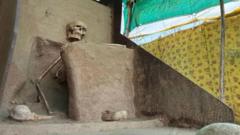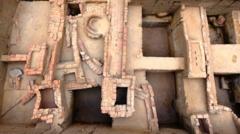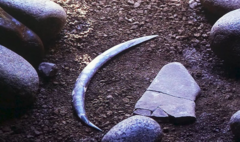The move of an ancient skeleton to a museum in Gujarat marks a significant event for archaeology enthusiasts, uncovering insights into India's rich historical practices.
Ancient Skeleton Finds Shelter: A Glimpse into India's Past

Ancient Skeleton Finds Shelter: A Glimpse into India's Past
A century-old burial discovery finally receives care and attention after years in limbo.
A 1,000-year-old human skeleton, discovered in a cross-legged sitting position, has found a new home in a museum in Gujarat after a lengthy delay of six years. Initially left unprotected under a tarpaulin shelter since its excavation in 2019, the skeleton's transition to the Archaeological Experiential Museum in Vadnagar was overseen by experts to ensure its safety.
Mahendra Surela, the museum's curator, stated that the skeleton was transported with meticulous care and will undergo examination by the Archaeological Survey of India (ASI) to decide on the ideal display approach. It is currently positioned near the reception area, protected by a barrier, with plans to move it upstairs, where a photograph of the skeleton has already been installed.
Discovered by archaeologist Abhijit Ambekar, the skeleton is believed to date back to the Solanki period, which spanned from 940 to 1300 CE. Ambekar expressed his satisfaction at the newfound attention for this significant piece of history, as similar remains have been found in only three other locations within India.
After years of inaction amidst bureaucratic disputes, the skeleton's transportation brings hope for further insights into ancient Hindu burial practices known as "samadhi burials," where revered individuals were laid to rest rather than cremated. This discovery not only enriches the understanding of historical practices but also highlights the importance of proper archaeological preservation.






















